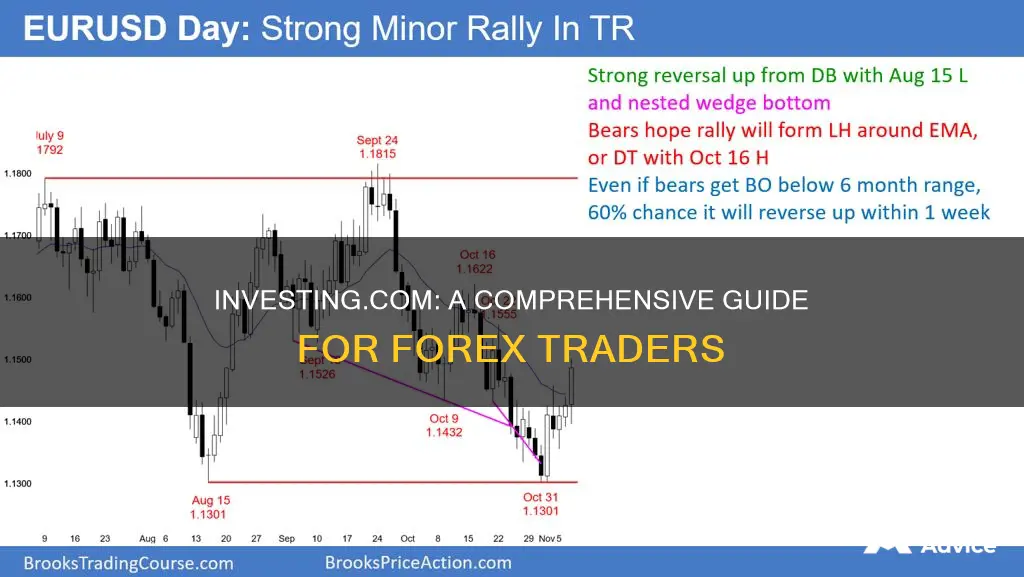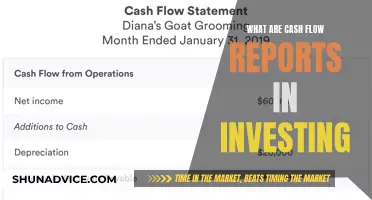
Investing.com offers a range of tools and resources for forex traders, including live forex charts, forex quotes, and educational content. The website provides real-time streaming forex quotes on over 2,000 currency pairs, as well as the U.S. dollar index and FX futures. It also features periodic performance tables for major currency pairs and a forex market heat map, which indicates the relative strength or weakness of major pairs.
In addition, Investing.com offers a comprehensive guide to forex trading, covering topics such as the history of forex, how forex trading works, the uses of the forex markets, basic forex trading strategies, and the pros and cons of forex trading. This guide is particularly useful for beginners as it provides an overview of the key concepts and strategies involved in forex trading.
Furthermore, Investing.com provides a list of the best forex brokers, making it easier for traders to find a reputable and regulated broker to open an account with. The website also offers a demo account feature, allowing traders to practice trading without risking any real money.
Overall, Investing.com provides a wealth of information and tools for forex traders, making it a valuable resource for those looking to enter or improve their performance in the forex market.
What You'll Learn

Understanding the risks and process of forex trading
The Forex Market
The foreign exchange (forex or FX) market is a global marketplace for exchanging national currencies. It is the world's largest and most liquid financial marketplace, with a daily trading volume of over $7.5 trillion. Forex trading involves buying one currency while selling another, with the aim of profiting from changes in their relative values.
The Process of Forex Trading
To start trading forex, you need to open a trading account with a broker that provides access to the FX market. After opening an account, you will need to deposit funds, which can be done through various methods such as bank transfers or debit cards. Once your account is funded, you can begin trading by placing buy or sell orders for currency pairs through your broker's trading platform.
Understanding the Risks
Forex trading carries several risks that traders should be aware of:
- Volatility and Speed: The forex market can move dramatically in seconds due to various factors, including economic reports, geopolitical events, and central bank announcements. This fast-paced nature of the market can make it challenging for even experienced traders to react in time.
- Leverage: Forex brokers often offer high leverage, which can amplify both gains and losses. While leverage allows traders to control large positions with a small amount of money, it can also lead to significant losses if the market moves against their position.
- Psychological Challenges: Forex trading can be emotionally demanding, leading to common pitfalls such as overtrading, holding losing positions too long, or making impulsive decisions.
- Institutional Disadvantage: Retail traders compete against institutional players with superior technology, better information access, lower transaction costs, and larger trading volumes.
- Market and Country Risk: Currency values are influenced by various factors, including a country's political stability, economic issues, and international relations. These factors can impact the volatility of the market and the value of specific currencies.
- Transaction Risk: Forex trading occurs 24 hours a day, and currency prices can change before trades are settled, leading to exchange rate risks.
- Counterparty Risk: This refers to the risk of default by the dealer or broker in a particular transaction. During volatile market conditions, the counterparty may be unable or unwilling to adhere to contracts.
Risk Management Strategies
While risks are inherent in forex trading, there are strategies to help mitigate them:
- Stop-Loss Orders: Using stop-loss orders can help limit potential losses by automatically closing trades at preset levels.
- Diversification: Diversifying your portfolio across multiple currency pairs can reduce vulnerability to fluctuations in a single pair.
- Proper Capitalization: Forex trading is a risky investment, and it's important to ensure you have sufficient capital to withstand potential losses.
- Risk Assessment and Planning: Understanding your risk tolerance, setting risk limits, and developing a trading plan can help manage risks effectively.
In conclusion, while forex trading offers significant opportunities, it is crucial to understand the risks involved and implement risk management strategies to minimize potential losses.
Factor Investing with ETFs: Strategies and Benefits
You may want to see also

Choosing a forex broker and opening an account
The first step in forex trading is to select a broker. The broker will provide access to the FX market. It is important to choose a broker that is regulated by a respected financial authority, such as the Commodity Futures Trading Commission (CFTC) in the U.S. or the UK Financial Conduct Authority (FCA) in the UK. Some other factors to consider when choosing a broker include:
- Account minimums: While forex trading accounts often have low minimum deposits, it is advisable to have a larger amount of risk capital to engage in meaningful trading. A balance of at least $2,500 is recommended.
- Customer service: Consider the quality of customer support offered by the broker, including the speed of response and the availability of automated assistance and chat functions.
- Fees: Forex brokerage fees are generally reasonable, but it is important to understand the fee structure, which may be based on a rate on the traded amount or wider bid/offer spreads.
- Number and quality of supported markets: Some brokers support a large number of currency pairs, but liquidity can vary significantly between markets. The top seven most actively traded pairs represent 75% of all FX trading.
- Demo accounts: Consider choosing a broker that offers demo trading to practice placing orders and managing positions without risking capital.
Once you have selected a broker, you can open a forex trading account by providing personal information, including your name, address, tax ID, and financial background. You will also need to answer questions about your finances and investment goals as part of the "know your customer" compliance process. If you plan to use leverage, you will also need to execute a margin agreement.
After your account has been approved, you will need to fund it before you can begin trading. Some platforms allow you to start with as little as $100, but it is important to remember that forex trading involves high leverage and can be risky. It is generally recommended to start with a larger amount of capital to manage your risk effectively.
AI for Investing: Strategies for Success
You may want to see also

Placing your first trade
Choose a Trading Platform and a Broker:
Select a reputable trading platform that suits your needs and offers a demo account. This will allow you to practice trading without risking real money. Oanda's FXTrade is a popular option. Also, research and choose a broker that is regulated and provides good customer support.
Understand the Basics:
Familiarize yourself with forex terminology, such as pips, lots, currency pairs, leverage, spreads, and margins. Know that forex trading involves buying one currency while selling another, with the goal of profiting from changes in their relative values.
Research and Analyse:
Keep yourself informed about market news and economic factors that influence currency values. Use technical indicators and charts to identify potential trading opportunities. In the example of AUD/JPY, you'd look for indicators suggesting a downtrend and JPY strength/AUD weakness.
Develop a Trading Strategy:
Create a trading plan that aligns with your risk tolerance and goals. Decide whether you want to go long (buy) or short (sell) based on your analysis. For instance, if you anticipate the US dollar strengthening against the pound, you'd go long on USD/GBP.
Place Your First Trade:
Using your trading platform, enter your desired currency pair, and specify the trade size (e.g., 10,000 units). Set a stop-loss order to limit potential losses and a take-profit order to secure profits. These steps are optional but highly recommended to manage risk effectively.
Monitor and Adjust:
After placing your trade, monitor it regularly. You may need to adjust your strategy based on market conditions. Remember that forex trading can be volatile, so it's crucial to have risk management measures in place, such as stop-loss orders.
Trade Completion:
Once your trade reaches the take-profit level or the stop-loss level, it will be automatically closed. Evaluate the outcome, reflecting on what went well and what could be improved. Remember that not all trades will result in profits, so always use risk management tools.
Continuous Learning:
Forex trading is a continuous learning process. Stay informed about market news, analyse your trades, and refine your strategy over time. Consider joining trading communities to connect with other traders and gain insights.
Remember that forex trading carries significant risks, and it's important to have a solid understanding of the market before committing large amounts of capital. Start with a demo account, practice your strategy, and gradually transition to live trading when you feel confident.
Smart Ways to Invest $10,000 for Maximum Returns
You may want to see also

Monitoring and managing your positions
- Regularly Monitor Your Trades: It is essential to keep a close eye on your trades and adjust your strategy as the market conditions evolve. Stay informed about market news, economic indicators, and geopolitical events that are likely to impact currency prices. Be prepared to adapt your strategy, but avoid overreacting to every minor price fluctuation.
- Set Take-Profit and Stop-Loss Orders: Utilise take-profit and stop-loss orders to manage your risk effectively. A take-profit order allows you to lock in profits at a predetermined price level, while a stop-loss order automatically exits a trade if it moves against you, limiting potential losses.
- Use One-Cancels-the-Other (OCO) Orders: Consider using OCO orders, which are a pair of linked orders. If one order is triggered, the other is automatically cancelled. This helps to automate your trading and ensure that you capture profits or limit losses according to your predefined levels.
- Practice Discipline and Emotional Control: Successful forex trading requires discipline and emotional control. Avoid impulsive decisions driven by fear or greed. Stick to your trading plan, including your predetermined risk management rules, even during periods of high market volatility.
- Consider Using Trading Journals: Maintaining a trading journal can be beneficial. Record your trades, including entry and exit points, reasons for your trading decisions, and the outcomes. This practice will help you identify patterns, strengths, and weaknesses in your trading approach, enabling you to refine your strategy over time.
- Risk Management: Always remember that forex trading involves significant risk. Do not risk more than you can afford to lose. Ensure you have adequate funds in your account to cover potential losses. Regularly evaluate your risk exposure and adjust your position sizes accordingly.
- Stay Informed About Market Conditions: Stay updated about the broader market conditions and trends. Monitor economic calendars for upcoming events and news releases that may impact currency prices. Be mindful of major economic indicators, such as interest rates, inflation rates, and geopolitical developments, as they can have significant effects on currency values.
- Technical Analysis: Utilise technical analysis tools and indicators to help you identify potential trading opportunities and make more informed decisions. Study price charts, identify trends, and use technical indicators to time your entries and exits more effectively.
- Fundamental Analysis: In addition to technical analysis, incorporate fundamental analysis into your decision-making process. Assess the economic and political health of the countries whose currencies you are trading. Factors such as interest rates, inflation, and geopolitical stability can influence currency values over the long term.
- Continuously Evaluate and Refine Your Strategy: Forex trading is a continuous learning process. Regularly review and evaluate the performance of your trading strategy. Identify areas where you can improve and make adjustments as necessary. Stay flexible and be prepared to adapt your strategy to changing market conditions.
ThinkorSwim: A Guide to Getting Started with Investing
You may want to see also

Managing your risk
As with any type of investing, the risk of losing money is the price you pay for the chance to profit. Forex trading can be profitable, but statistics show that the majority of traders lose money. Major factors leading to trader losses include inappropriate use of leverage, lack of education, and costs of trading such as spreads or commissions.
Forex trading can be highly volatile, so it's important to have risk management measures in place. Never risk more than you can afford to lose, and consider using tools like stop-loss orders to automatically exit trades if the market moves against you.
The leverage available in forex trading can amplify your gains, but it can also magnify your losses. If you want to reduce your chance of losing more than you can handle, you might try reducing your leverage.
Because the currency market moves so frequently, and there's almost always trading happening, it's easy to make and lose large amounts of money. Before you start, understand the risks. People have lost everything by trading on margin in the forex market.
Tips for Managing Risk
- Learn the basics: Before trading, familiarize yourself with common forex terminology, such as pips, lots, and currency pairs. You’ll also need to understand how leverage, spreads, and margins work, as these factors directly impact your potential gains and losses.
- Analyze the market: Successful forex traders rely on both fundamental and technical analysis. Fundamental analysis focuses on economic data, interest rates, and geopolitical events that affect currency values, while technical analysis involves using charts and indicators to predict price shifts from past performance.
- Develop your trading plan: Determine and acknowledge your risk tolerance, trading goals, and strategy before placing any trades. Set how much capital you’re willing to risk per trade and select stop-loss and take-profit levels to lower your potential losses.
- Monitor and manage your positions: Once you’ve chosen a currency pair and analyzed the market, place a buy (long) or sell (short) order through your broker’s platform. Monitor your trades regularly and adjust your strategy based on market conditions.
- Never risk more than you can afford to lose: Forex trading can be volatile, so it’s important to have risk management measures in place.
- Use tools like stop-loss orders: These will automatically exit trades if the market moves against you.
Fidelity Investments: High-Frequency Trading Strategies and Secrets
You may want to see also
Frequently asked questions
Forex, or FX, is short for foreign exchange, and it involves trading currencies in the global market. It is the largest and most liquid financial market in the world, with trillions of dollars traded daily.
Before starting to trade Forex, it is beneficial to spend some time learning about the market and factors such as the risks of using leverage. You will then need to open an account with a top Forex brokerage firm, which can usually be done online via the broker's website. It is advisable to work with a broker regulated by a top-tier government agency, such as the UK Financial Conduct Authority (FCA).
Forex trading strategies can be broken down into fundamental and technical strategies. Fundamental strategies involve trading based on economic news, such as interest rates and geopolitical events. Technical strategies rely on an analysis of price data, such as identifying price breakouts or using chart patterns to predict price reversals or continuations.







